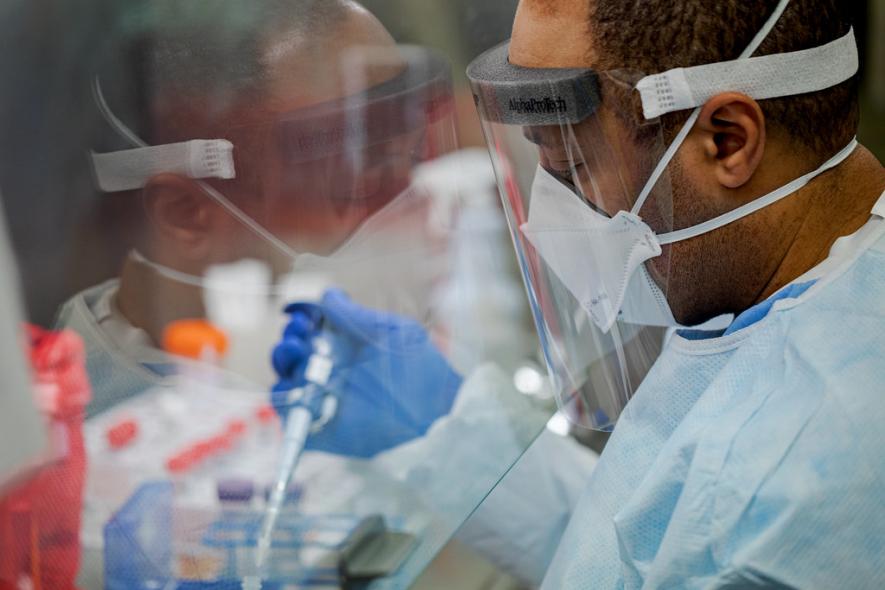India Cannot Beat Covid-19 with Only a Lockdown

Representational image. | Image Courtesy: flicker
Covid-19 infections are still mounting at a very rapid rate in most countries of the world. After China, several countries with superior public health infrastructure, including Italy, the United States, Spain and France are grappling with this pandemic. Fortunately, India is not amongst the worst-affected countries by the Novel Coronavirus which causes the Covid-19 disease. As of 23 April India had reported 21,797 Covid-19 cases and the total number of deaths was 681 while 4,376 people had recovered. Of course, these numbers are changing fast, but about three days ago, a country with an 18% share in the world population had reported 0.82% of the total Covid-19 cases detected thus far in the world. Simultaneously, India accounted for 0.37% of the death toll associated with the pandemic, again as on 23 April.
Some believe that the general Indian population may have developed a “herd immunity” against Covid-19 as a result of the country’s long battle against tuberculosis and malaria. Some attribute the “immunity” to Indian climactic conditions, or to its demographic profile—only 8.7% of the population is 60 years or over, according to the latest Census conducted in 2011.
But there is not enough evidence to support the “herd immunity” argument. The circumstances are such that India needs to strengthen its healthcare systems and infrastructures, and it needs to prepare strategies to combat the spread of the disease. India, like many middle- and low-income countries, has been unable to procure enough Covid-19 test kits. Without intensive testing, only a lockdown cannot be the solution, for this outbreak is likely to overpower the health system whenever the lockdown restrictions are lifted.
Table 1: Relation Between Tests and Tracing of Covid-19 Cases
There is a wide disparity in testing for detection of Covid-19 infections across countries. As on 21 April, the United States and Italy had conducted 4 and 1.4 million tests—or 12.2 and 23.1 thousand tests per million of their population—respectively, while India had only managed to do 291 tests per million population.
On 16 March, the WHO Director General Tedros Adhanom Ghebreyesus had called for more intensive testing for Novel Coronavirus across countries. He clearly said, “We cannot stop this pandemic, if we don’t know who is infected.” The experiences of other countries also shows that there is a positive correlation between tests per million population and tracing Covid-19 cases (see Table 1).
Our estimate also shows that elasticities of tracing Covid-19 cases with respect to number of tests are significantly high and positively significant. At the world level, a 1% increase in the number of tests may increase tracing of Covid-19 cases by 0.96%. The significant positive correlation holds good for almost all regions.
Table 2: Test and Tracing Covid-19 Cases: Asian Countries
Table 2 demonstrates the level of test and case intensity (per million population) for Asian countries. Among the 40 Asian countries that are reporting their statistics on number of tests per million population, India is among the bottom five. It is one of the countries with low test intensity (only 291 tests per million), even among her neighbours.
Stand-alone non-medical interventions such as a lockdown and social distancing, without intensive testing for Covid-19, cannot defeat the virus. In the early stages of this pandemic, these non-medical interventions may have been a temporary solution to cripple the rate at which the infection is spreading, and thereby buy some more time to widen the testing coverage and prepare the health system.
But India’s unprecedented lockdown has gone on for more than three weeks, and it may shrink three-fourths of its economy. Moreover, the lockdown has already started taking a heavy toll. The country has experienced the largest exodus since Partition: millions of poor and vulnerable migrant workers are fleeing the cities, and in the absence of any means of transport, they have walked back to villages after losing their livelihood during the lockdown.
This huge reverse migration may also infect Indian villages and disrupt Indian agriculture.
India should learn from Hong Kong, which has kept infections and the associated loss of life from Covid-19 significantly low, without locking down the economy. Given the size of its economy, India needs a mixture of widespread testing, which will then allow effective tracing of Covid-19 cases. This has to be done along with preventative measures such as social distancing, quarantine and temporary locking down of the economy. At the same time, with every day of lockdown without aggressive testing facilities, India is moving farther away from a quick recovery from this pandemic. The need is for many more millions to be tested and a follow-up policy before the lockdown is lifted and the economy is reopened in full swing again.
Pritam Datta is a fellow at the National Institute of Public Finance and Policy (NIPFP), New Delhi and Chetana Chaudhuri is a researcher at the Public Health Foundation of India (PHFI), Gurugram. The views are personal.
Get the latest reports & analysis with people's perspective on Protests, movements & deep analytical videos, discussions of the current affairs in your Telegram app. Subscribe to NewsClick's Telegram channel & get Real-Time updates on stories, as they get published on our website.
























